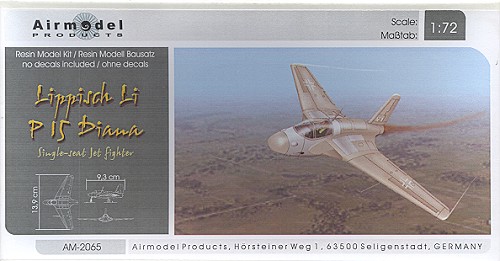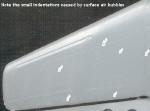
| KIT: | Airmodel 1/72 Lippisch P.15 "Diana" |
| KIT #: | 2065 |
| PRICE: | € 19.00 plus shipping from www.airmodel.de |
| DECALS: | None |
| REVIEWER: | Scott Van Aken |
| NOTES: | Resin kit with vacuformed canopy |

| HISTORY |
A development of the Me-163, the P.15 was to be powered by a single HeS 011 turbojet. The nose of the aircraft, which was to hold two 30mm cannon was to be taken from the He-162. Wings are the same as on the Me-163 with a slightly longer span thanks to the engine intake section at the wing roots. Other borrowed bits include the Bf-109 main landing gear. The end of the war put a halt to the development of this aircraft, though Northrop did use some of the technology to develop its X-4 "Bantam" to explore 'tail-less' aircraft.
| THE KIT |
 Airmodel's
kit is molded in a nice, medium grey resin. It has been superbly packaged
in a compartmentalized plastic bag where there are no more than two sprues
per section. It has finely engraved detailing and overall, the impression
one gets is quite good. The detail bits are very nicely done and quite
scale. The molding itself is done in such a manner that one is not faces
with large resin molding plugs aside from the fin. This makes clean-up very
easy and something one can do with a sharp hobby knife.
Airmodel's
kit is molded in a nice, medium grey resin. It has been superbly packaged
in a compartmentalized plastic bag where there are no more than two sprues
per section. It has finely engraved detailing and overall, the impression
one gets is quite good. The detail bits are very nicely done and quite
scale. The molding itself is done in such a manner that one is not faces
with large resin molding plugs aside from the fin. This makes clean-up very
easy and something one can do with a sharp hobby knife.
 The
fuselage/wings are done as a single casting. A hollowed out area for the
cockpit is provided and one simply glues in all the needed bits. Intakes
are hollowed out and one basically adds the nose, exhaust and fin to
complete the airframe. I should mention that the upper surface of the
review kit's wings have a myriad of small indentations and a few holes
caused by air bubbles. This is not uncommon on short run resin kits and an
application or two of Mr. Surfacer should fill these without any real
problems. None of the other bits were so affected, though there are a few
areas where it looks as if the molds had been scratched and so there is a
small build-up on the surface. Again, easily sanded away.
The
fuselage/wings are done as a single casting. A hollowed out area for the
cockpit is provided and one simply glues in all the needed bits. Intakes
are hollowed out and one basically adds the nose, exhaust and fin to
complete the airframe. I should mention that the upper surface of the
review kit's wings have a myriad of small indentations and a few holes
caused by air bubbles. This is not uncommon on short run resin kits and an
application or two of Mr. Surfacer should fill these without any real
problems. None of the other bits were so affected, though there are a few
areas where it looks as if the molds had been scratched and so there is a
small build-up on the surface. Again, easily sanded away.
The cockpit consists of a seat, control stick, rudder pedals, instrument panel (with raised detailing) and the nose gear 'bump'. There is absolutely no room anywhere for additional nose weight and no indication if any is needed. The wheelbase is not particularly long so perhaps it would be wise to leave off the nose until one is sure. It could be hollowed out if needed. The landing gear is very well done and quite scale. I've been worried about all resin gear deforming under the weight of solid resin aircraft, but so far, only one of my many resin kits has done this, so I guess it is strong enough. The various retraction struts and gear doors are also provided. The only bit one has to make is a pitot tube. A single vac canopy is provided and the plastic is fairly thick. I'd have liked to have had a spare, just in case, but I'm sure that Airmodel will be able to supply a second if you botch this one.
Instructions are very well done and consist of a large sheet of folded paper. Page one is a short history and a nice three-view of the aircraft. The second page has the two well-drawn construction steps, while the third is an parts layout. The back of the instructions provides two 'what if' schemes; one of a prototype in metal and RLM 02, while the second is in late war colors of RLM 81/82/76. Of course, one can do this aircraft any way one sees fit. It is the fun of these types of models. Markings will have to come from the spares bin.
| CONCLUSIONS |
Overall, it really is an excellent little kit. This is probably the least expensive one in their inventory, and one that would be quite good for those who are ready to tackle their first full resin kit. Stay tuned for a full build review.
August 2005
My thanks to Airmodel for the review kit. You can order direct from www.airmodel.de
If you would like your product reviewed fairly and quickly by a site that has around 300,000 visitors a month, please contact me or see other details in the Note to Contributors.